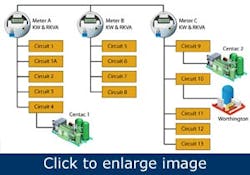Energy monitoring provides data to optimize air compressor efficiency
When Thomson purchased RCA from General Electric, operations continued at RCA facilities, including those in Indianapolis, Indiana. This plant was quite large, with a central boiler plant providing chilled water, compressed air, heat and domestic hot water to several buildings spread over more than 80 acres. Thomson needed a way to identify and track energy use in the various systems and equipment on this campus.
To get the needed data, Thomson-RCA installed an AutoPilot Energy Information System, comprising Opto 22 hardware and software and designed by Holmes Energy. Using analog and digital interfaces that connected Opto 22 I/O processors to field equipment via multiple I/O modules, the Autopilot System was able to monitor 108 I/O points. The monitored machinery and equipment included gas and electric meters, as well as chillers, cooling towers, boilers and water heating equipment. The AutoPilot System also monitored the facility’s compressed air system. This, in turn, enabled tracking of the electrical demand, power consumption, with system pressure, and airflow associated with two 500-hp Centac compressors and one 350-hp Worthington compressor.
The monitoring system initially was intended only to monitor energy use and offer real-time screens detailing the status of each monitored point, both individually and as a part of a group. But the system also provided human-machine interface (HMI) screens that offered data archiving and historical reports, as well as charts and graphs showing consumption and power demand in 15-min intervals, along with monthly and annual totals.
[pullquote]As Thomson underwent internal restructuring, it placed greater emphasis on utility cost reduction. Based on the reports the AutoPilot system generated, attention and scrutiny turned toward the compressed air system, its excessive energy use and actions that could be taken to curb this demand. As a result of reviewing the monthly reports, Thomson noticed a significant variation in the compressed air system’s efficiency based on the demand for air and which compressor or compressors were operating. The most obvious difference seemed to occur when the Worthington unit, the smallest compressor, could satisfy demand by itself during the third shift and on weekends when air consumption was much lower.
Another somewhat startling discovery was that the AutoPilot system reported the compressed air system’s efficiency varied wildly, from a low of 148 cf/kW to a high of 191 cf/kW — a 30% difference.
Thompson experimented with different compressor combinations and loads to better understand the characteristics of the three compressors, identify how many kW each was consuming, explain the variations in their efficiencies and find each one’s optimum operating variables.
In one such experiment, the first Centac compressor required 380 kW, the second Centac slightly less than 350 kW and the Worthington less than 250 kW. Based largely on the data the AutoPilot system aggregated, it became clear that running the Worthington alone on weekends offered the greatest opportunity for savings. In addition to the advantage of the Worthington unit over the bigger Centac units during low demand periods, the AutoPilot system revealed that under all conditions the Centac 2 unit was more efficient than what was thought to be an identical Centac 1.
To reconfigure the operating sequence of its compressed air systems, Thomson-RCA implemented an energy monitoring system.
“Discoveries such as this — those that offer tremendous revenue saving opportunities — are only made possible through the close examination that real-time monitoring provides,” says Bill Holmes of Holmes Energy, designer and integrator of the AutoPilot system. “But before one can even begin to consider how to cut costs, before any control can or should be exercised, and even before energy usage behavior can change, one needs first to observe closely and measure accurately.”
Thomson’s boiler plant personnel used the data to change the operating sequence for the three compressors to maintain the highest overall system efficiency under any operating condition. They modified the controls to allow the Worthington to be the primary unit with the Centac units serving as automatic backups.
The data, and some quick math work, had shown conclusively that with good compressor management, a demand reduction of approximately 175 kW could be achieved and the compressed air requirements could still be satisfied. After implementing the new operating procedures to put the Worthington in the lead position, compressed air reports showed that the 175-kW demand reduction resulted in a monthly consumption drop of nearly 64,000 kWh. Air compressor electrical costs were reduced by 20%, leading to an annual cost savings in excess of $35,000.
With such positive results, it wasn’t long before Thomson expanded use of the AutoPilot System. “In addition to tracking the power, we also began monitoring the individual equipment in the powerhouse and other facility systems,” says John Munchel, Thomson’s manager of maintenance. “With that information, we were able to assign accurate dollar figures on what it cost to generate compressed air, chill water and produce steam.”

